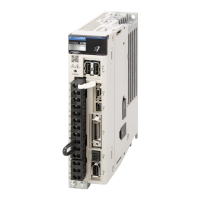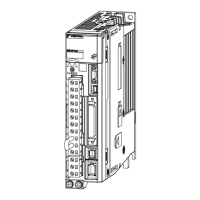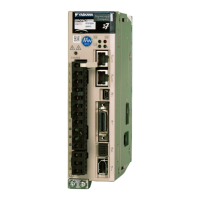8.3 Troubleshooting Based on the Operation and Conditions of the Servomotor
8-52
8.3
Troubleshooting Based on the Operation and Conditions of the Servomotor
This section provides troubleshooting based on the operation and conditions of the Servomo-
tor, including causes and corrections.
Problem Possible Cause Confirmation Correction Reference
Servomotor
Does Not
Start
The control power supply is
not turned ON.
Measure the voltage
between control power
supply terminals.
Turn OFF the power
supply to the servo
system. Correct the
wiring so that the con-
trol power supply is
turned ON.
–
The main circuit power sup-
ply is not turned ON.
Measure the voltage
across the main circuit
power input terminals.
Turn OFF the power
supply to the servo
system. Correct the
wiring so that the main
circuit power supply is
turned ON.
–
The I/O signal connector
(CN1) pins are not wired cor-
rectly or are disconnected.
Turn OFF the power sup-
ply to the servo system.
Check the wiring condi-
tion of the I/O signal con-
nector (CN1) pins.
Correct the wiring of
the I/O signal connec-
tor (CN1) pins.
–
The wiring for the Servomo-
tor Main Circuit Cables or
Encoder Cable is discon-
nected.
Check the wiring condi-
tions.
Turn OFF the power
supply to the servo
system. Wire the cable
correctly.
–
There is an overload on the
Servomotor.
Operate the Servomotor
with no load and check
the load status.
Turn OFF the power
supply to the servo
system. Reduce the
load or replace the Ser-
vomotor with a Servo-
motor with a larger
capacity.
–
The type of encoder that is
being used does not agree
with the setting of Pn002 =
n.X (Encoder Usage).
Check the type of the
encoder that is being
used and the setting of
Pn002 = n.X.
Set Pn002 = n.X
according to the type of
the encoder that is
being used.
–
Settings for input signals
Pn630 to Pn64D are incor-
rect.
Check settings of input
signals Pn630 to Pn64D.
Correct the settings of
input signals Pn630 to
Pn64D.
–
The /S-ON (Servo ON) signal
was not received.
Check the commands
sent from the host con-
troller.
Tur n ON the /S-ON sig-
nal from the host con-
troller.
–
The P-OT (Forward Drive
Prohibit) or N-OT (Reverse
Drive Prohibit) signal is still
OFF.
Check the P-OT and N-
OT signals.
Turn ON the P-OT or
N-OT signal.
–
The current position of the
servomotor is outside the
software limit setting range.
Check for INDEXER
errors.
Check the motor posi-
tion and software limit
setting (Pn638 and
Pn63A), then move the
servomotor into the
software limit setting
range.
–
There is no position refer-
ence, or it is incorrect.
Check for INDEXER
errors.
Set the program table
correctly.
–
Continued on next page.

